Key takeaways:
- Difficult questions can spark self-reflection and meaningful dialogue, transforming discomfort into growth opportunities.
- Recognizing personal triggers helps manage emotional responses, allowing for more confident and clear communication in challenging situations.
- Techniques such as active listening, pausing before answering, and using “I” statements can foster collaborative and productive discussions.
- Practicing real-life scenarios aids in confidently addressing tough questions, promoting constructive conversations and deeper connections.
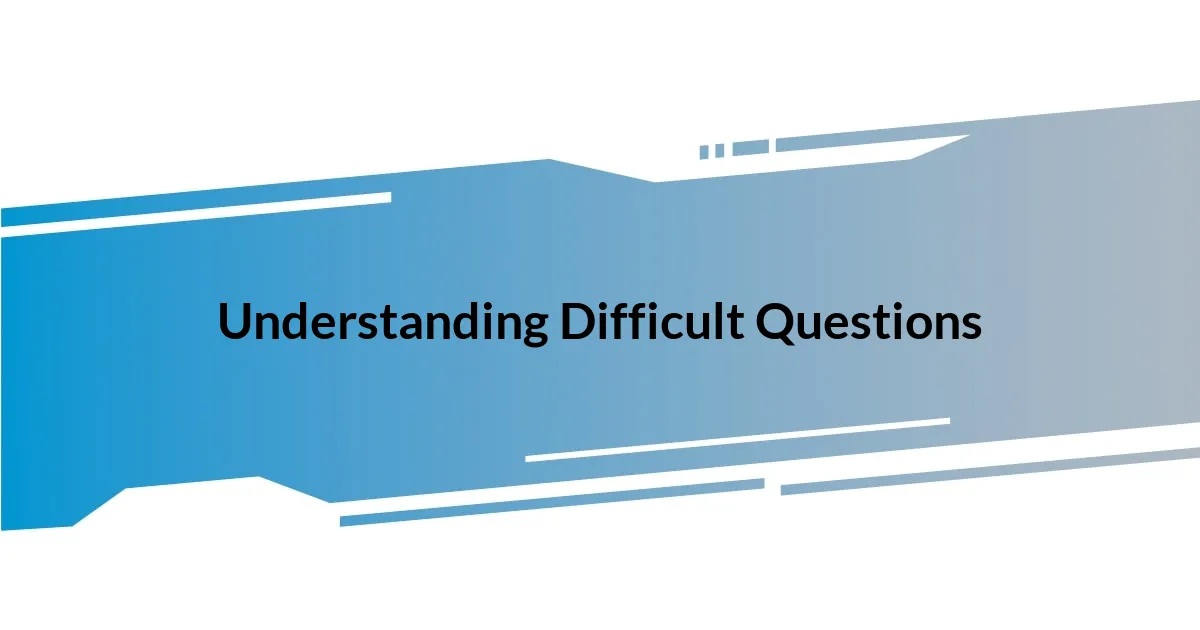
Understanding Difficult Questions
Difficult questions can often feel like unexpected roadblocks, challenging our comfort zones. I remember once during a team meeting when someone asked about my long-term career goals. My immediate thought was, “Why is this relevant right now?” This personal experience taught me that these questions can provoke self-reflection and spur deeper conversations than we often anticipate.
In many situations, a difficult question can initiate important dialogue, revealing insights that may have remained hidden. When I faced a pressing question during a panel discussion about ethical dilemmas in my field, I felt a wave of vulnerability wash over me. It’s these moments that remind us: Why do we shy away from discomfort? Difficult questions can bridge the gap between superficial exchanges and meaningful interactions.
Navigating challenging inquiries pushes us to think critically and respond thoughtfully. I’ve noticed that my emotional response to these situations can range from anxiety to excitement, depending on the context. Isn’t it fascinating how one question can transform an entire atmosphere? Understanding the nature of difficult questions allows us to embrace them as opportunities for growth rather than obstacles to avoid.
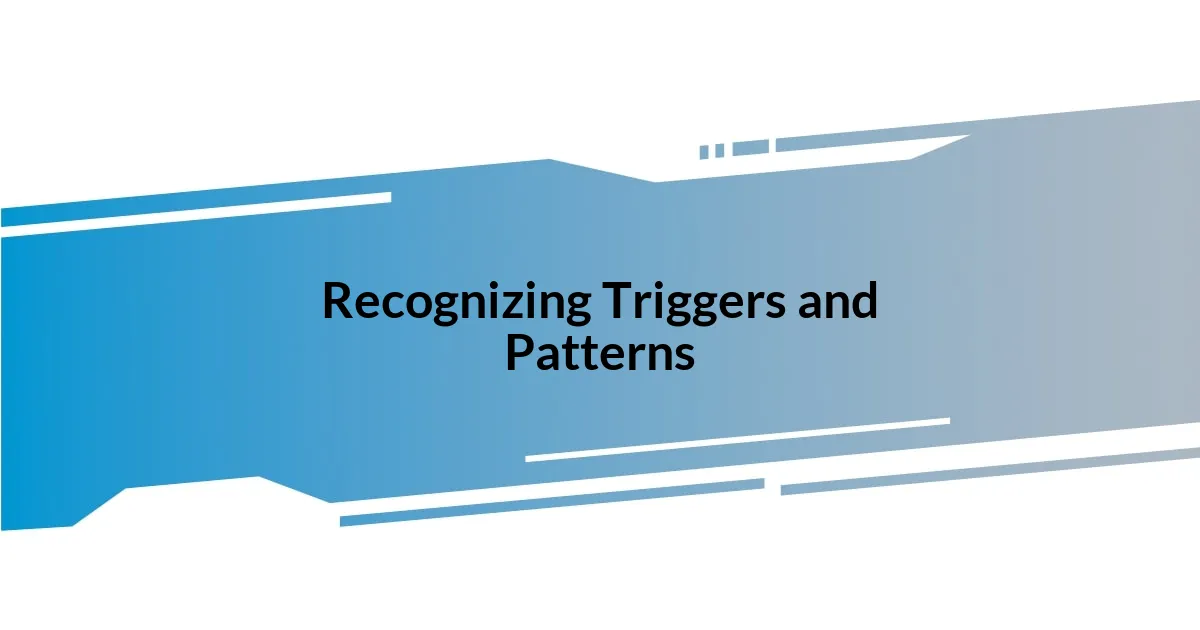
Recognizing Triggers and Patterns
Recognizing the triggers that spark anxiety in me has been a crucial part of handling difficult questions. For instance, I’ve realized that I tend to feel uneasy when I’m asked to delve into personal beliefs during large group settings. In those moments, my heart races, and I often catch myself fidgeting. Over time, patterns emerged showing that conversations about values and ethics amped up my stress levels.
Here’s what I’ve identified as common triggers for myself:
– Being put on the spot without preparation.
– Questions that challenge my values or beliefs.
– Negative past experiences with similar inquiries.
– Contexts where I feel judged or unsupported.
– High-stakes environments where opinions are heavily scrutinized.
Recognizing these patterns not only empowers me to prepare but also helps me anticipate my emotional responses. As a result, I can approach these moments with more confidence and clarity. Understanding my triggers has turned them from stumbling blocks into signposts for growth.
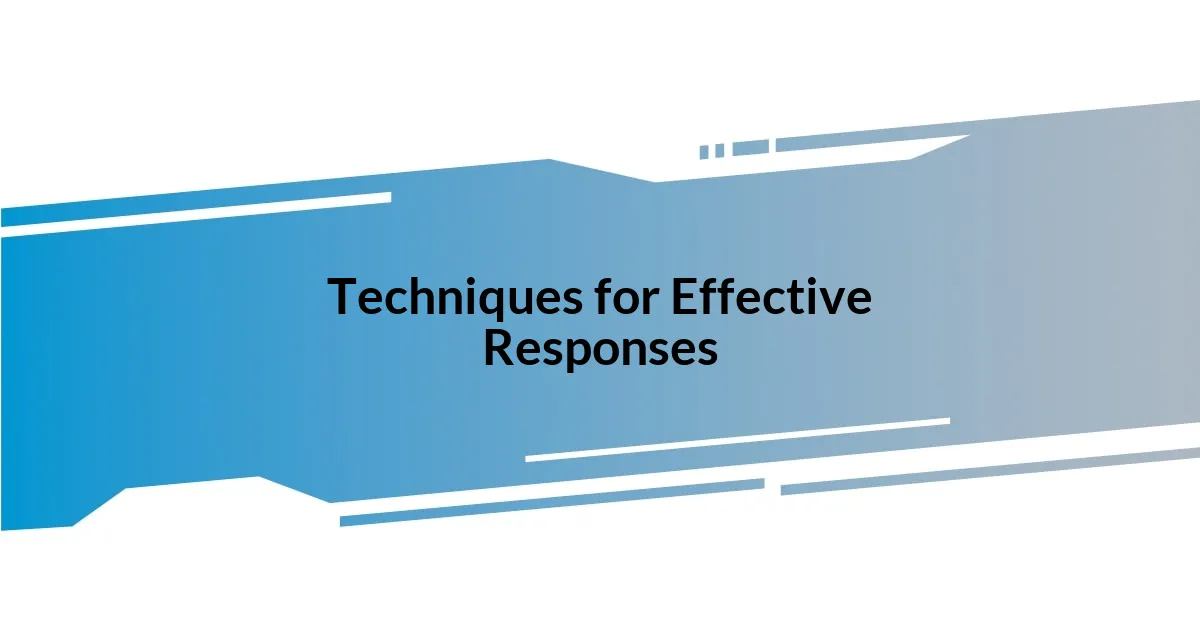
Techniques for Effective Responses
One powerful technique I find useful is the practice of active listening. I remember a time during a challenging interview when I was asked a difficult question about my leadership failures. Instead of reacting impulsively, I focused on the speaker, absorbing their words. This helped me not only understand their concern but also frame my answer more thoughtfully. By acknowledging their feelings and clarifying their question, I was able to respond in a way that felt genuine and relevant.
Another technique I often employ is pausing before answering. I have learned that taking a moment to gather my thoughts can significantly enhance the quality of my response. There was a moment in a past discussion when someone challenged my project’s direction. Instead of defending my choices immediately, I paused and reflected. This brief silence shifted the conversation, allowing me to articulate my rationale clearly. That simple act of pausing turned a defensive reaction into an opportunity for deeper engagement.
Lastly, I’ve found that using “I” statements can transform my responses from defensive to collaborative. For instance, when asked about differing opinions in a team meeting, I framed my thoughts as, “I feel that we should consider…” This approach not only conveys my perspective but also invites others to share theirs, fostering a more inclusive dialogue. I often think about how language shapes interactions, and I strive to use it intentionally in these tough moments.
| Technique | Description |
|---|---|
| Active Listening | Engaging fully with the speaker to understand and respond thoughtfully. |
| Pausing | Taking a moment before answering to gather thoughts and improve response quality. |
| “I” Statements | Framing responses to emphasize personal feelings and invite collaboration. |
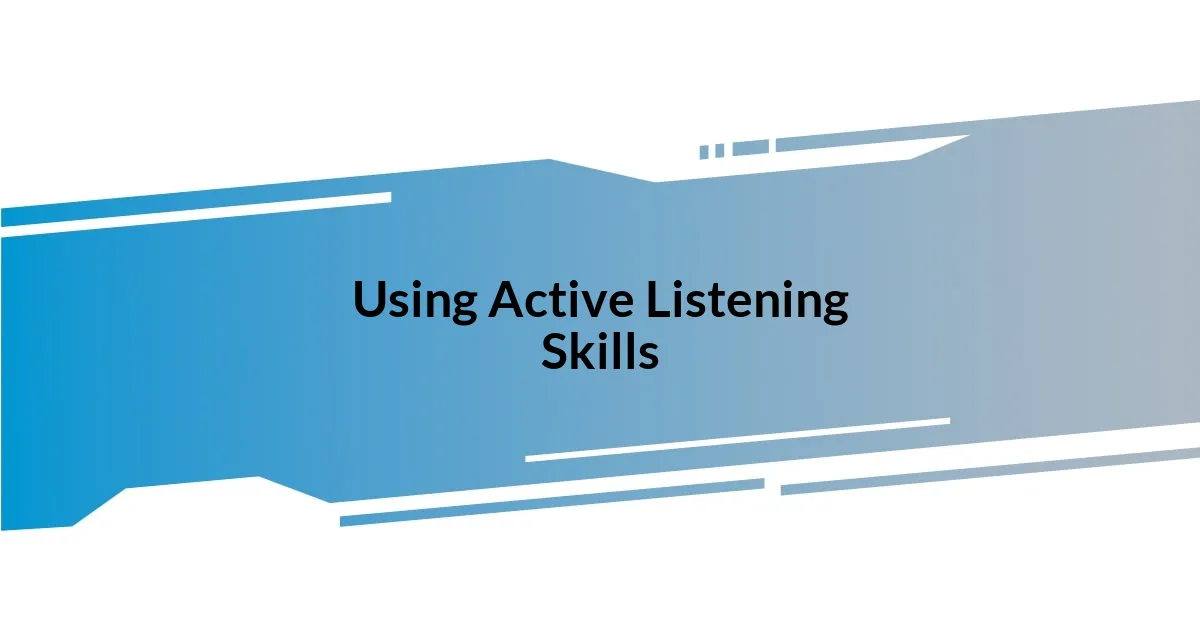
Using Active Listening Skills
In my experience, active listening isn’t just about hearing the words; it’s about really getting into the speaker’s shoes. I remember a particularly heated discussion where emotions ran high. Instead of zoning out or planning my response, I focused intently on what my colleague was saying. This shift made all the difference. By nodding and asking follow-up questions, I not only validated their feelings but also created a more open atmosphere, which led to a more productive conversation.
There have been times when I realized that simply repeating back what I heard—not as a challenge but as a genuine effort to understand—worked wonders. One instance comes to mind when a teammate expressed frustration about project timelines. By paraphrasing their concerns, I noticed their tension ease a bit. It’s fascinating how reflecting back what someone shared can reaffirm their feelings, allowing for a smoother dialogue. Isn’t it interesting how much connection can arise from simply showing you care enough to listen?
I also find that embracing pauses in a discussion fosters deeper understanding. When I’m faced with challenging questions, taking a moment to absorb what’s been said can turn moments of tension into opportunities. I once found myself in a group meeting where the atmosphere felt charged. When I paused before responding, I could see others contemplating my words, creating a shared moment of reflection. This isn’t just about waiting your turn to talk; it’s about respecting the conversation and making it a two-way street. Have you ever noticed how a little silence can invite profound insights?
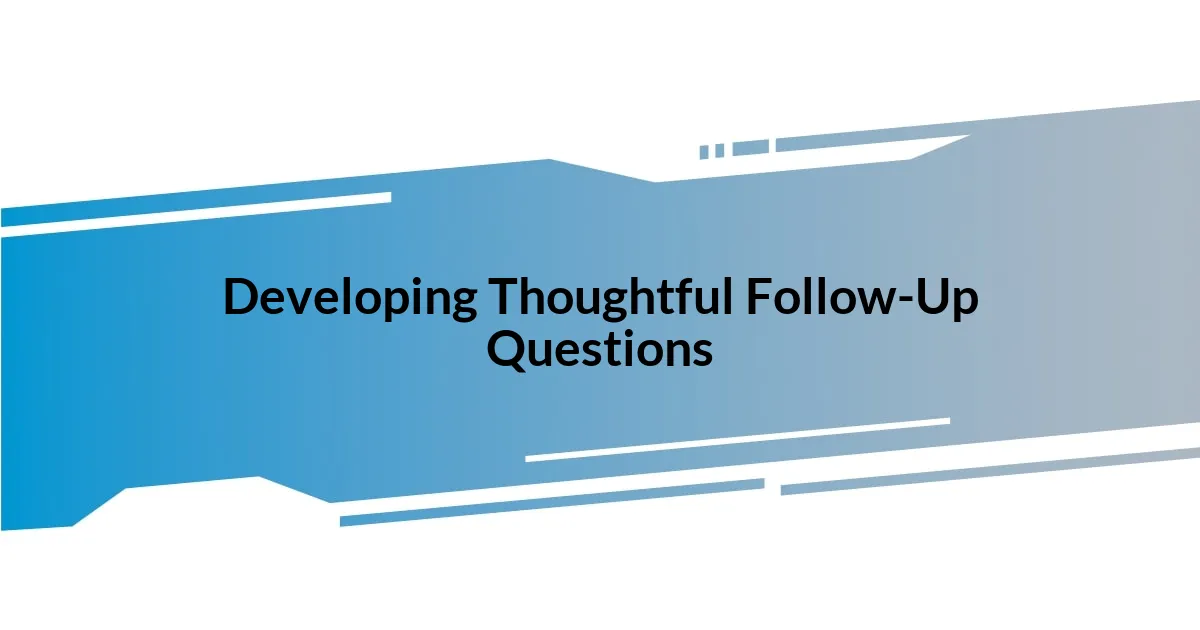
Developing Thoughtful Follow-Up Questions
As I delve into developing thoughtful follow-up questions, I often consider how such inquiries can enrich the conversation. For instance, during a brainstorming session, a colleague expressed their vision for a project, and instead of simply affirming or debating their idea, I asked, “What inspired your perspective on this?” This question not only deepened our discussion but also encouraged my colleague to share valuable insights I hadn’t anticipated. It’s moments like these that reveal how a simple follow-up can lead to a more profound understanding.
I remember one instance in a feedback meeting where I noticed the presenter seemed a bit defensive when addressing critiques. Instead of pressing harder on the issues, I chose to ask, “What do you see as the biggest challenge in implementing this feedback?” This approach softened the atmosphere and prompted a candid conversation about obstacles we could work on together. It’s fascinating how a well-placed question can shift the dynamics from confrontation to collaboration, leading to more constructive outcomes.
Thinking back, I’ve realized that follow-up questions can also serve to clarify not just the content of what’s being said, but the emotions behind it. One time, I asked a friend who was going through a tough time, “How are you really feeling about this situation?” This question opened up a floodgate of emotions and reflections that I hadn’t expected. It made me think how powerful it is to create space for others to express themselves. Do you find that inviting deeper reflections in conversations can lead to more meaningful connections?
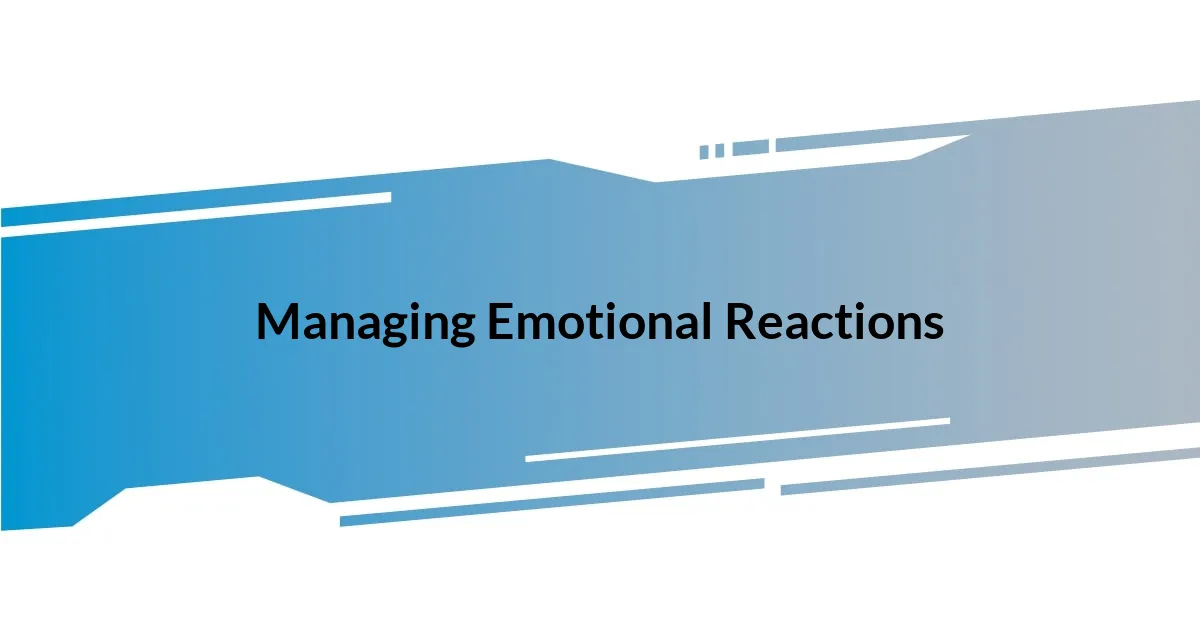
Managing Emotional Reactions
It’s inevitable that difficult questions can sometimes trigger emotional reactions. I’ve encountered moments when a hard question caught me off guard, and my initial instinct was to become defensive. I remember during a performance review when my manager asked about a setback I’d faced. My heart raced, but instead of letting panic take over, I took a deep breath. That pause allowed me to transform my defensiveness into a genuine reflection. It’s remarkable how a mere breath can shift your mindset from reaction to insight.
During tense discussions, I find that acknowledging my emotions can be liberating. There was a time in a team meeting when a project point struck a nerve, and I felt frustration bubbling up inside me. Instead of suppressing that feeling, I shared it candidly. I said, “I’m feeling a bit overwhelmed by this, and I want to process it.” To my surprise, my honesty encouraged my colleagues to share their struggles too. Have you ever realized that naming your emotions can actually deepen empathy and create a safer environment for everyone involved?
In navigating emotional reactions, maintaining perspective is crucial. I recall a challenging client interaction where harsh criticism was thrown my way. Though my initial reaction was to take it personally, I forced myself to look at the bigger picture and consider where the client was coming from. By reminding myself that their frustration stemmed from their own pressures, I found the emotional weight lifting. I think many of us can benefit from reframing our perspective in tough situations. How do you remind yourself to look beyond the immediate emotions? It’s a practice that has truly helped me keep conversations constructive.

Practicing with Real-Life Scenarios
Practicing with real-life scenarios has been instrumental in honing my response to difficult questions. One day, while preparing for a panel discussion, I simulated a high-pressure situation by asking myself tough, unexpected questions. For instance, when I challenged myself with, “What will you say if someone questions your expertise?” I discovered that, rather than feeling intimidated, I could address my experience with confidence. It was like facing a mirror—I learned to articulate my thoughts clearly and assertively.
In another instance, I joined a workshop focused on navigating tough conversations. During a role-playing exercise, I was tasked with addressing a colleague’s performance issues. Initially overwhelmed, I recalled a past experience where I focused on the person’s strengths first. So, I said, “I appreciate your dedication to the project, but I’ve noticed a few areas where we can improve together.” Doing this not only eased the tension but also opened a pathway for constructive dialogue. Have you ever noticed how framing difficult discussions positively can change the entire atmosphere?
Reflecting on these practices, I’ve come to appreciate how vital it is to adapt my responses to various scenarios. I think about a family gathering where a relative posed a sensitive question about my career choices. Instead of dodging it, I engaged them by saying, “It’s interesting you bring that up; I’ve faced some tough decisions lately.” This prompted a heartfelt conversation that not only satisfied their curiosity but also helped me articulate my own journey. How often do we miss opportunities for connection by avoiding tough topics? Embracing these moments can deepen our relationships and understanding of one another.